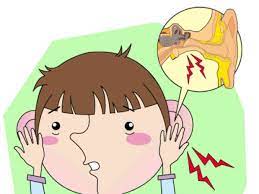According to Toy EC, et al (2011), acute otitis media is a state of ear pain, fever, and other symptoms that cause the tympanic membrane to become red, opaque, stiff, and lumpy.
Acute otitis media is an infection of the middle ear caused by the entry of pathogenic bacteria into the middle ear (Smeltzer, 2001).
According to Schwartz MW, et al (2004) and Soepardi EA, et al (2007), the most common bacterial pathogens are Streptococcus pneumoniae, undifferentiated Haemophilus influenzae, Moraxella catarrhalis, Hemolytic streptococcus, Staphylococcus aureus, Escherichia coli, Proteus vulgaris and Pseudomonas. Usually, this otitis media is found in children.
Signs and symptoms according to Toy EC, et al (2011) and Meadow SR, et al (2005) are pain in the ear (otalgia). A feeling of fullness in the ear or a sense of hearing loss. In infants usually have a high fever, restlessness, moving his head from side to side or rubbing his ears, diarrhea, anorexia, vomiting. Convulsions and sometimes holding the ear that hurts. When the tympanic membrane is ruptured, secretions will flow out of the ear and the child's body temperature will decrease.
The pathophysiology of AOM begins when germs enter the body through the nose or mouth resulting in upper respiratory tract infection (ARI) or allergies, resulting in congestion and edema of the upper respiratory tract mucosa, including the nasopharynx and Eustachian tube. The Eustachian tube becomes narrow, resulting in a blockage of negative pressure in the middle ear. If this situation persists for a long time, it will cause reflux and aspiration of viruses or bacteria from the nasopharynx into the middle ear through the Eustachian tube. The middle ear mucosa relies on the Eustachian tube to regulate the continuous ventilation of the nasopharynx. If there is interference due to tubal obstruction, it will activate a complex inflammatory process and fluid effusion will occur into the middle ear. This is a precipitating factor for AOM and otitis media with effusion. When the Eustachian tube is blocked, the middle ear drainage is disturbed, there is infection and accumulation of secretions in the middle ear, then there is a proliferation of pathogenic microbes in the secretions. As a result of viral upper respiratory tract infection, the released cytokines and inflammatory mediators will cause Eustachian tube dysfunction. Respiratory viruses can also increase bacterial colonization and adhesion, thereby interfering with the patient's immune defenses against bacterial infection. If secretions and pus increase from the local inflammatory process, hearing may be impaired because the tympanic membrane and ossicles cannot move freely against vibrations. Accumulation of too much fluid can eventually tear the tympanic membrane due to increased pressure. Eustachian tube obstruction can occur intraluminally and extraluminally. Intraluminal factors are as a result of ARI, where the inflammatory process occurs, then there is edema of the tubal mucosa and accumulation of secretions in the middle ear. In addition, most patients with otitis media are associated with a history of abnormal function of the Eustachian tube, so that the mechanism of tubal opening is disturbed. Extraluminal factors such as tumors, and adenoid hypertrophy.
5 Nursing Diagnosis for Acute Otitis Media :
- Acute pain related to middle ear tissue auditory inflammation
- Anxiety related to health status
- Alterations sensory / perceptual (auditory) related to obstruction, infection in the middle ear or damage to the auditory nerve
- Social isolation related to pain, foul-smelling otorrhoea
- Knowledge deficit related to cognitive limitations and lack of interest in learning
- Toy EC., Girardet, R., Yetman, R. 2011.
- Schwartz MW., Bell L., Brown Lawrence., Clark Bernard., Kim Susan., Manno, C. 2004.
- Wilkinson JM & Ahern NR. 2011.

